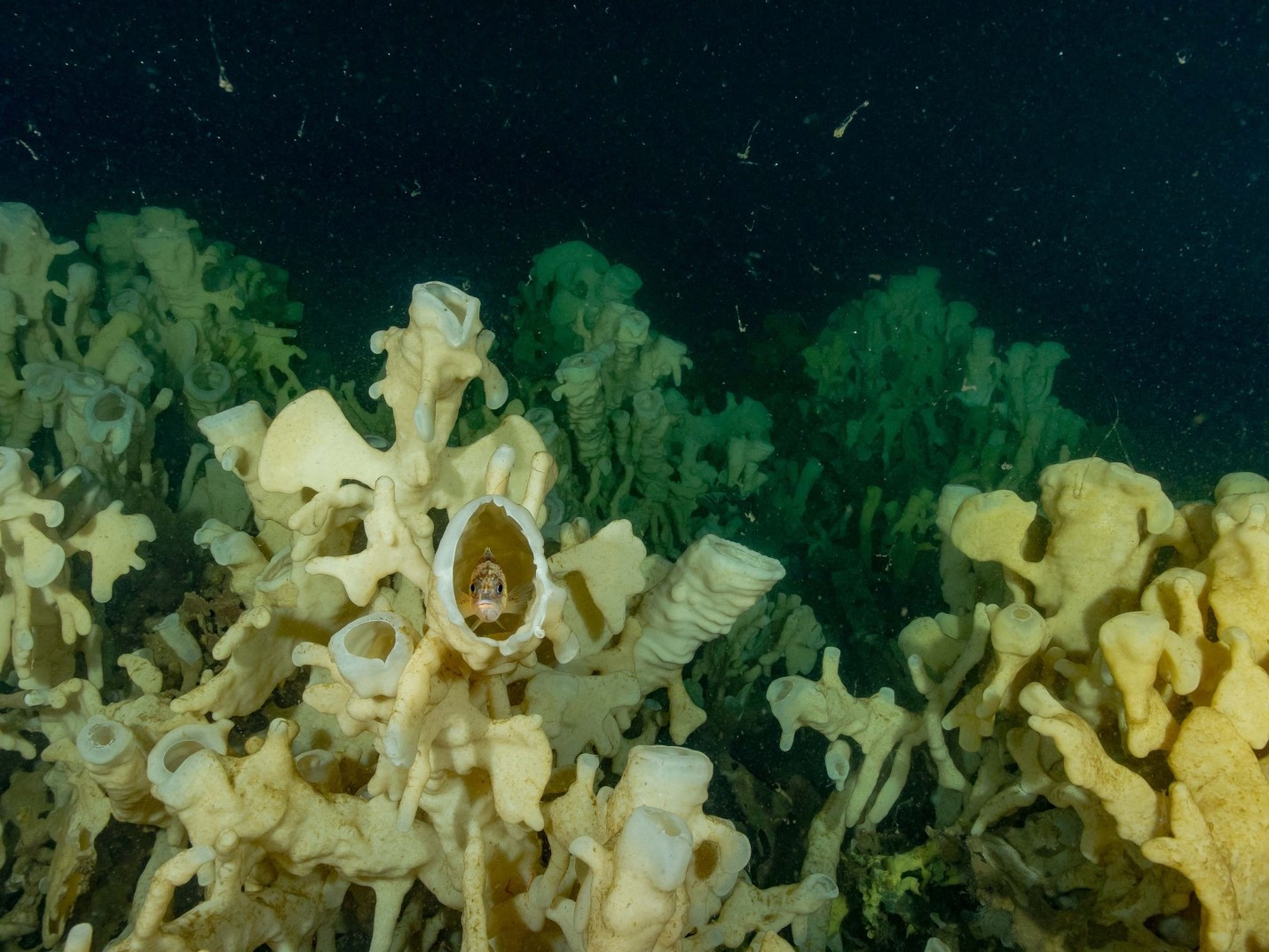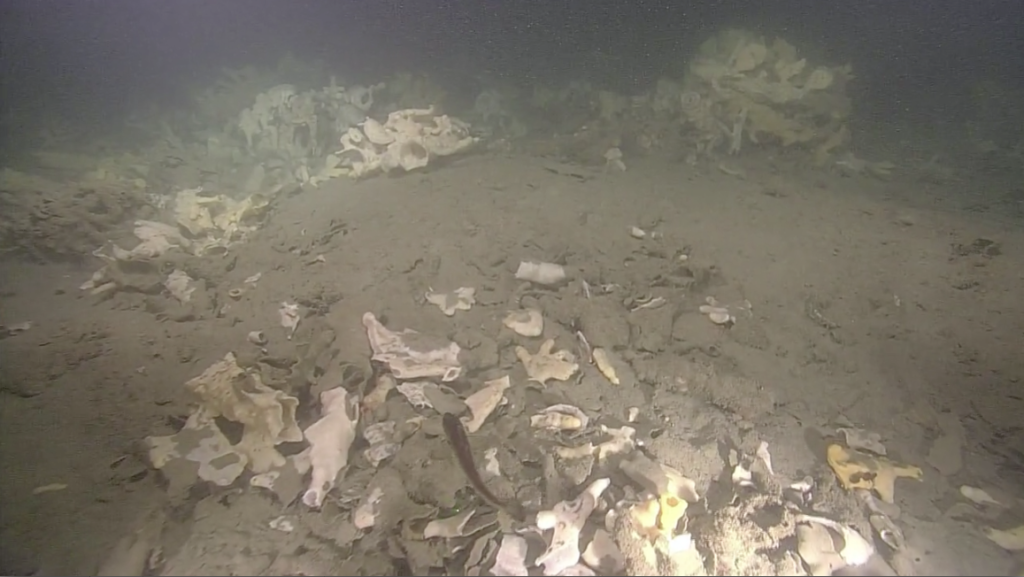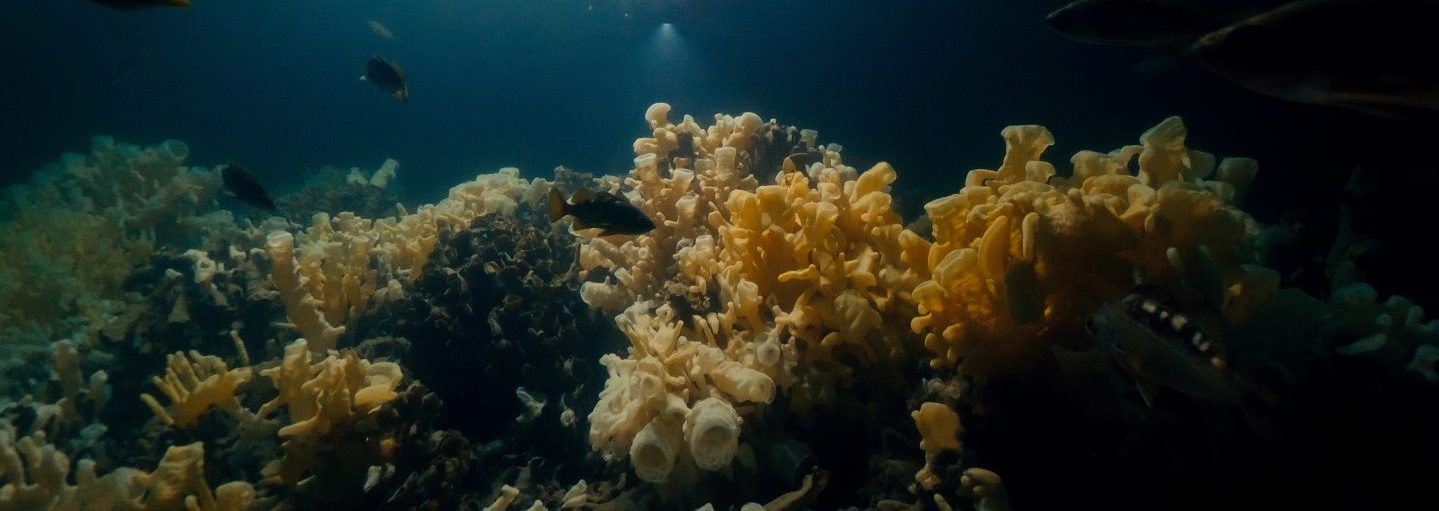Once thought to have gone extinct 40 million years ago, one of the worlds most incredible animals, the glass sponge in 1986 was re-discovered off the coast of British Columbia in the Hecate Straight region [1]. Although this discovery sparked a certain hope for the survival of these animals, the actual reality for many instead invoked fear. A fear that we may be losing these animals once again but this time due to human mediated extinction and at rates faster than our oceans can cope with it.
 Mosaic of individual glass sponges near Texada Island, Strait of Georgia, British Columbia. © Ocean Wise Research Institute
Mosaic of individual glass sponges near Texada Island, Strait of Georgia, British Columbia. © Ocean Wise Research Institute
The Value of a Reef Full of Glass
Although described by many researchers as living dinosaurs, glass sponges are in no way primitive or simple but instead constitute the heart of some of the most complex, important, and productive ecosystems off the coast of BC. Some of these reefs are as old as 9000 years old and can cover up to 1000 square kilometres of seafloor reaching heights similar to that of a eight story tall building [2]. The towering reefs not only provide crucial habitat for wide range of native species but a study by Archer et al (2020) showed that 12 species are consistently and reliably dependent upon this habitat including BC’s endangered rock fish [3,4]. Glass sponge reefs additionally aid in carbon sequestration and also play essential roles in water quality by filtering microbes and sediments. A glass sponge reef only a kilometre in length can filter up to 80,000 litres a second, which is the equivalent of filtering an olympic swimming pool in less than a minute [5,6].
 Rockfish inside barrel of glass sponge in a reef near Gambier Island, Howe Sound, British Columbia. © Adam Taylor, Marine Life Sanctuaries Society
Rockfish inside barrel of glass sponge in a reef near Gambier Island, Howe Sound, British Columbia. © Adam Taylor, Marine Life Sanctuaries Society
Where are the Reefs Located ?
Since initial discoveries in 1980’s glass sponge reefs have now been found stationed along most of the lower coast in BC with Hecate Straight and Queen Charlotte Sound representing some of the largest known reefs as seen on the map below.

Glass sponge reef locations along the Pacific Coast. Reef names in the Strait of Georgia correspond to fishing closure nomenclature in DFO Fishery Notice FN0415. Reefs in Howe Sound are not shown here. Retrieved from Martone et al (2018)
The Broken Glass Problem
With skeletons made of glass, these reefs are some of the most delicate and fragile ecosystems in the entire world, and are susceptible too many human mediated pressures that are conducted on along the coastlines of BC.
 Recently destroyed glass sponge reef : Credit: Jackson Chu and Sally Leys / ROPOS
Recently destroyed glass sponge reef : Credit: Jackson Chu and Sally Leys / ROPOS
Fishing
Heavy bottom fishing gear such as traps, long lines, and trawls nets can easily damage or crush extensive amounts of reef and is considered the main threat to glass sponge reefs. It was estimated by scientists that by the time the sponge reefs were discovered in BC, fishing actives had already destroyed half of them [7].
Sedimentation
Glass sponges will stop filtering water when turbidity gets too high. Large sediment plumes from human actives such as aquaculture, anchors, cables, and fishing activities commonly choke out, starve, and smother these reefs. Sediments as far away as six kilometres can affect the feeding of glass sponges [8]. Linked below is an underwater video of a dead glass sponge reef that was smothered in wastes and feces from a nearby fish farm.
Climate Change
Ocean warming reduces 50–60% of the sponges ability to pump water through its tissue which can lead to starvation and ocean acidification is significantly weakening their skeletal systems making them more susceptible to breakage. On a wide scale this is leading to reduced reef building capacities [9].
So What is Being Done?
Since their discovery in 1986, it was not until 2015 when the first glass sponge reefs received strict protection from all commercial, recreational, and social disturbances. It then took 6 more years to when the last remaining reefs were protected. Interactive maps of protected sponge reefs in the Atl’ka7tsem/Howe Sound region can be found here and in the Queen Charlotte Sound region here. Unfortunately although all known reefs are now protected as refuges, only a few are actually permanent and there is little enforcement to ensure all practices have stopped [10]. Consequently more action needs to take place to protect this unique ecosystem for without it, ecosystems collapse could occur and along with it, humans.
 Credit : Nate Slaco’s Moonless Oasis
Credit : Nate Slaco’s Moonless Oasis
Show your support for BC’s Sea of Glass and send a letter to the Minister of Fisheries and Oceans Canada to better protect our glass sponge reefs.
Minister : Joyce Murray Email : min@dfo-mpo.gc.ca
For more news on glass sponge reef protection in BC you can follow the link here
Resources
[1] Krautter, M, Conway, K.W., and Barrie, V.J. 2006. Recent Hexactinosidan sponge reefs (silicate mounds) off British Columbia, Canada: frame-building processes. J. Paleont. 80(1):38-48.
[2] Conway, K.W., Barrie, J.V., and Krautter, M. 2004.Modern siliceous sponge reefs in a turbid, siliciclastic setting: Fraser River delta, British Columbia, Canada. Neues Jahrbuch fur Geologie und Palaontologie Monatshefte 6(6):335-350.
[3] Cook, S.E. 2005. Ecology of the Hexactinellid sponge reefs on the Western Canadian continental shelf. Masters thesis, University of Victoria, Victoria, Canada.
[4] Archer, S. K., Kahn, A. S., Thiess, M., Law, L., Leys, S. P., Johannessen, S. C., … & Dunham, A. (2020). Foundation Species Abundance Influences Food Web Topology on Glass Sponge Reefs. Frontiers in Marine Science, 7, 799.
[5] Chu, J. W. F. and Leys, S. P. 2010. High resolution mapping of community structure in three glass sponge reefs (Porifera, Hexactinellida). Marine Ecology Progress Series. 417: 97-113.
[6] Kahn, A.S, Yahel, G., Chu, J.W.F., Tunnicliffe, V. and Leys, S.P. (2015). Benthic grazing and carbon sequestration by deep-water glass sponge reefs. Limnology and Oceanography. 60(1):78:88.
[7] Conway, K.W., Krautter, M., Barrie, J.V., and Neuweiler, M. 2001. Hexactinellid sponge reefs on the Canadian continental shelf: a unique “living fossil”. Geoscience Canada. 28(2):71-78.
[8] Leys, S.P. 2011. Effects of Sediment on Glass Sponges (Porifera, Hexactinellida) and projected effects on Glass Sponge Reefs. DFO Can. Sci. Advis. Sec. Res. Doc. 2013/074. vi + 23 p.
[9] Stevenson, A., Archer, S. K., Schultz, J. A., Dunham, A., Marliave, J. B., Martone, P., & Harley, C. D. G. (2020). Warming and acidification threaten glass sponge Aphrocallistes vastus pumping and reef formation. Scientific reports, 10(1), 1-11.
[10] CPAWS. (2022). Conservation. Glass Sponge Reefs. Retrieved February 1, 2022, from https://glassspongereefs.com/conservation/